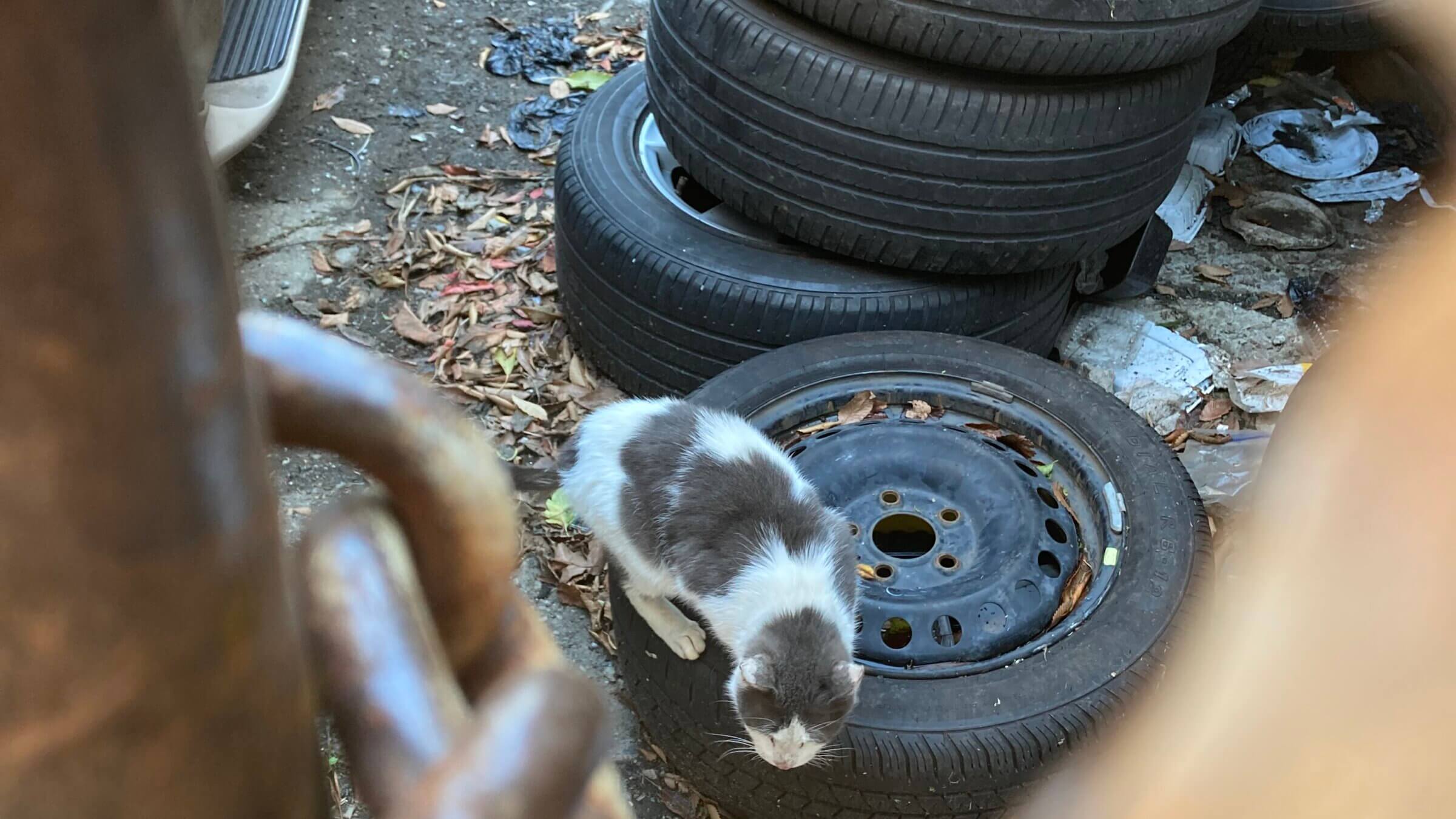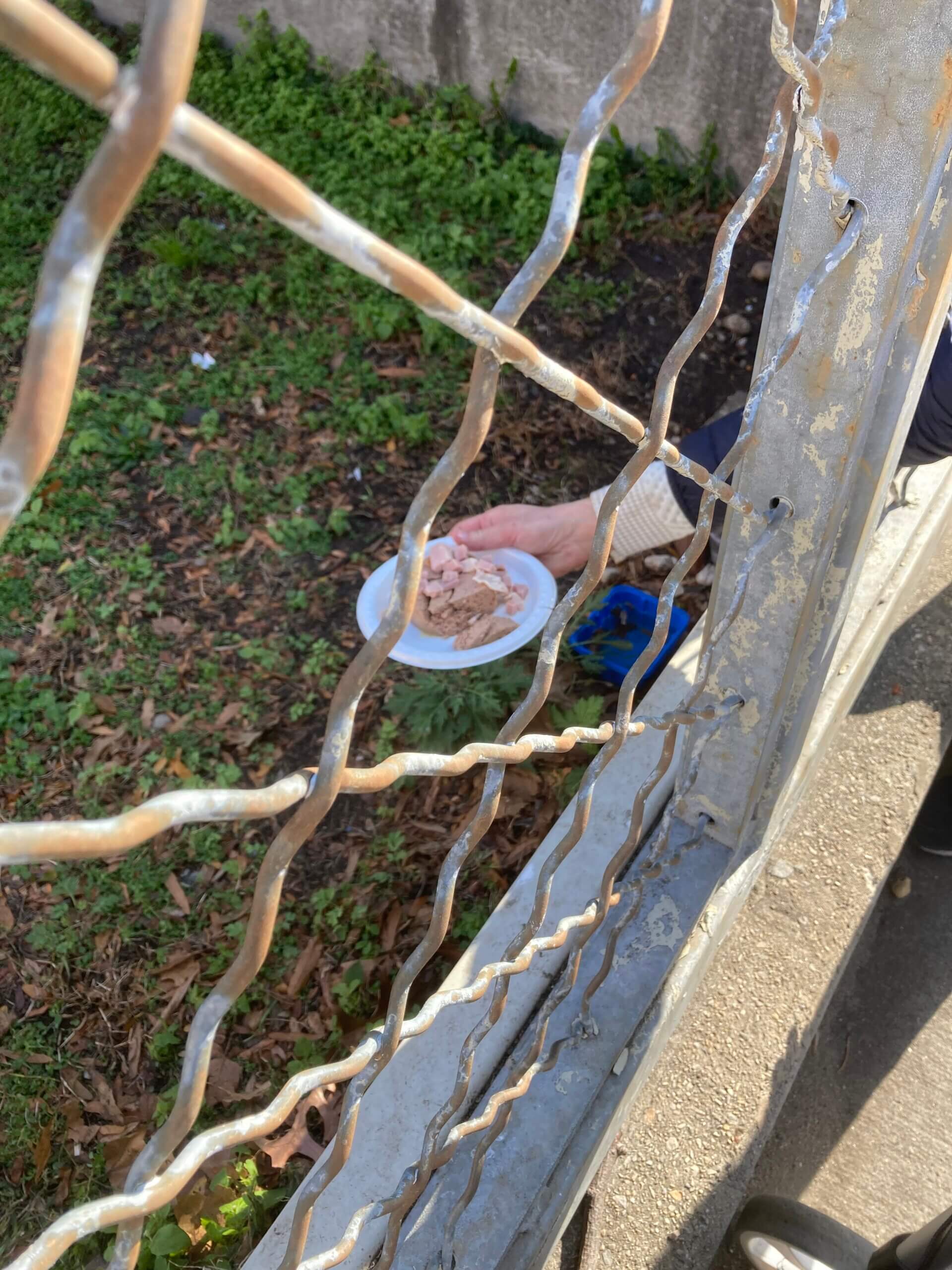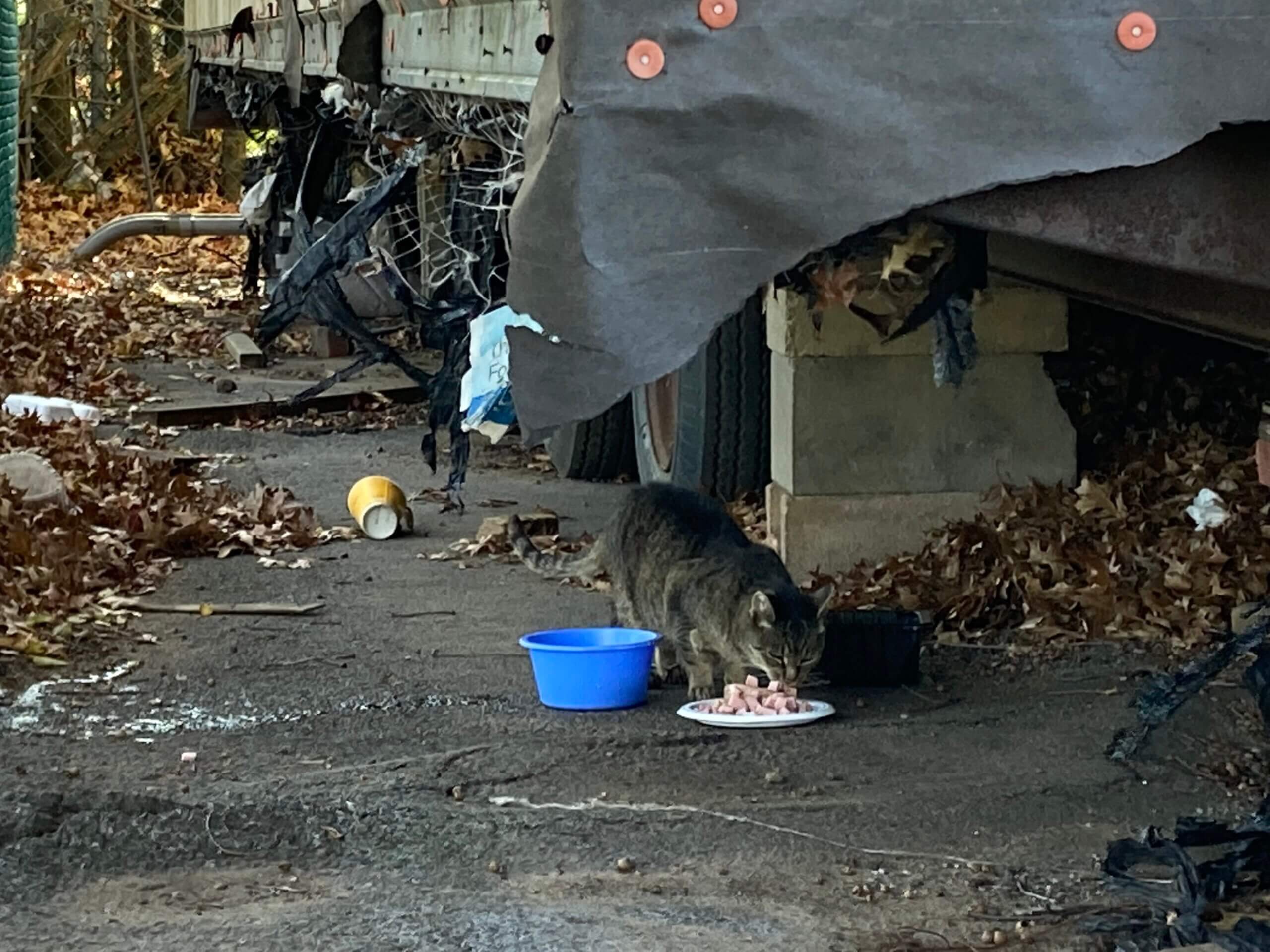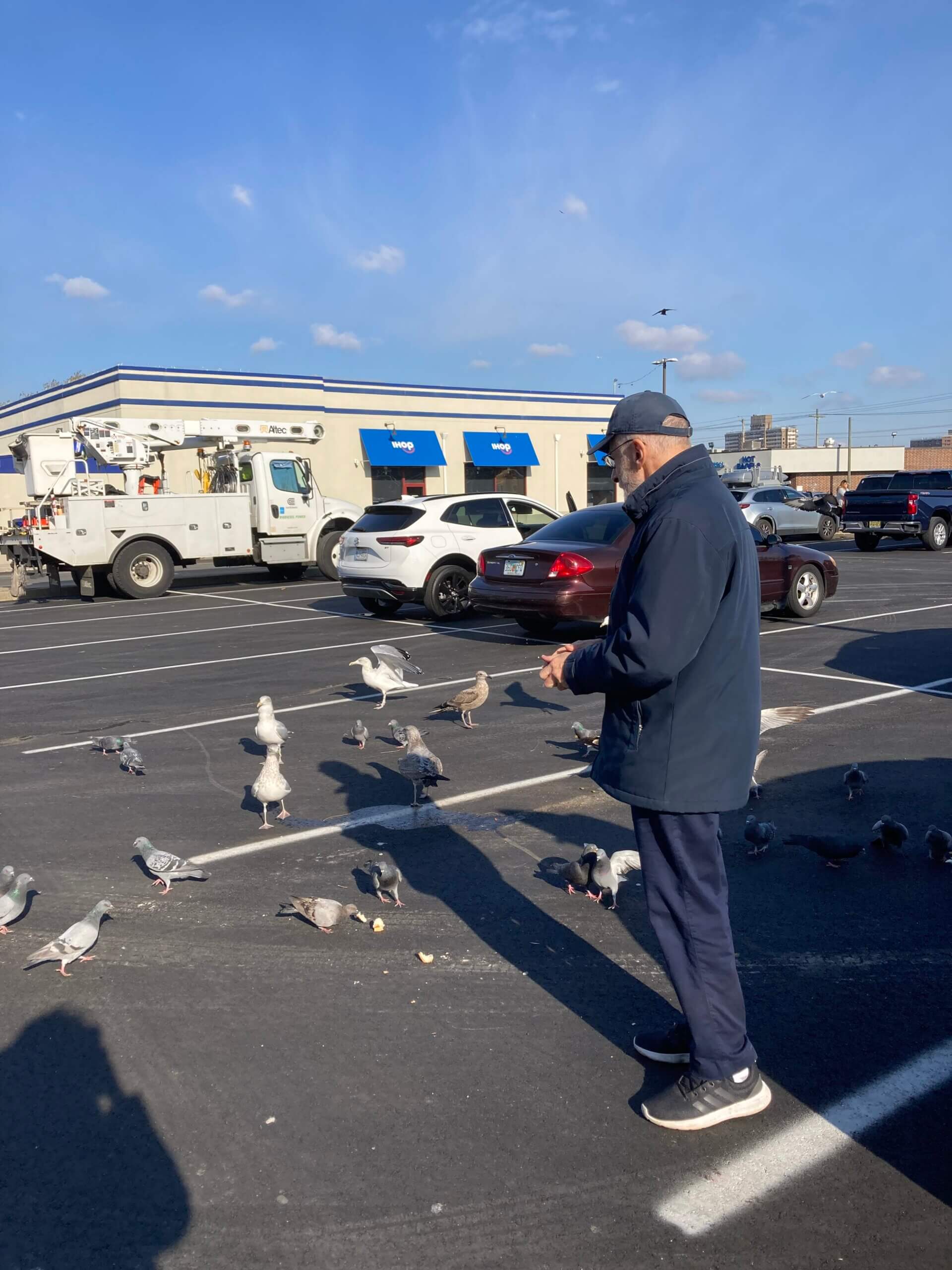This Orthodox New Yorker feeds more cats than you
I followed a Jewish cat rescuer on his morning rounds to see what it’s like caring for feral felines in a city that doesn’t want to deal with them

Awaiting breakfast behind an auto body shop in Canarsie. Photo by Irene Katz Connelly
Gregory Kaplun had just one question before we crept into the backyard of the White House: “Are they going to throw stones at us?”
Lana shrugged; she didn’t know. It was early on a frigid November morning and no one seemed to be watching, so we decided to risk it. Kaplun, a trim, gray-bearded man with a slight Russian accent and a yarmulke peeking out from a baseball cap emblazoned with the words “Support Animal Rescue,” lifted the latch and silently eased open the iron gate.
We scurried up the White House’s brick path to a weedy, overgrown side yard. Just visible under the bushes were a few styrofoam boxes covered in heavy-duty trash bags. They looked like rubbish, but until summer 2022 they had been comfortable homes for a colony of feral cats. After inspecting the yard, Kaplun decided we should make a quick getaway before anyone detected our presence.
As you may have guessed, the White House in question is not the heavily guarded home of the president of the United States but a humble building in Canarsie, notable only for the ongoing feud between its inhabitants and the cat rescuers who want to make use of the premises.
Since 2014, with the blessing of the building’s previous owner, Lana had been maintaining a colony of feral cats in the yard: Feeding them daily, taking them to get vaccinated and neutered, and setting up styrofoam shelters filled with straw to keep them warm in the winter. (Lana asked to be identified by only her first name to protect the privacy for her cat-feeding operations.) When the building changed hands, the new tenants weren’t thrilled with the prospect of hosting a cat colony. While, to date, no one has thrown stones at Lana, the new tenants have communicated in no uncertain terms that she needs to find the cats a new home.
But such a relocation is easier demanded than accomplished. Once we were safely ensconced in his sedan, Kaplun explained that even feral cats can’t survive when suddenly dropped in an unfamiliar environment. Moreover, it’s illegal to simply dump unwanted cats on someone else’s block, to become someone else’s problem. Lana has removed most of the colony’s 12 cats and raised funds to send them to a cat sanctuary in Maryland. Still, she continues to place food around the White House, in case any felines are still visiting in search of sustenance. This hasn’t exactly improved relations with the owners.
“They hate me,” Lana said simply, as we sped toward the next stop on our route — because she doesn’t leave food just at the White House. A home health aide working in Canarsie, she’s identified about 10 cat colonies on her commutes to and from work. Six days a week, she treks out to feed them.
Kaplun, 70, is an Orthodox Jewish cat rescuer and self-appointed guardian of felines in distress, not only in Midwood, where he lives, but across Brooklyn. Once or twice a week, he acts as a chauffeur for Lana, 57, whom he met through the Russian-speaking cat rescue community. They’d invited me to join them so that I could see what it’s like to advocate for feral cats in a city that doesn’t really want to be bothered with them. The responsibility they’ve assumed requires crossing a lot of boundaries — physical, and otherwise.

An estimated 500,000 feral cats live at large in New York City, and their human neighbors have never agreed on the best way to manage them. Advocates like Kaplun argue that cats have a right to safe and humane accommodation. Moreover, they say, cats are a useful part of an urban ecosystem, acting as a free extermination service for rats and other pests (in the era of the rat czar, an especially winning trait).
In the 1950s, British animal rights activists who opposed the euthanization of stray cats pioneered a technique called Trap-Neuter-Return (TNR) to curb cat reproduction and prevent the spread of disease. After carefully trapping feral cats, rescuers take them to the vet; there, the cats receive vaccinations and get neutered, and kittens can be put up for adoption. Rescuers then return adult cats who can’t be socialized to their original colonies. American rescuers began practicing TNR informally in the 1990s.
By the early 2000s, TNR had become a mainstream practice in New York City. Organizations like Neighborhood Cats and Bideawee now provide instruction in humane cat trapping — unsurprisingly, it’s not easy to entice a wild animal into a weird-looking box — and keep databases of cat colonies in the city, many of which are maintained by volunteer rescuers like Kaplun and Lana.
But even when feral cats are disease-free and infertile, many New Yorkers just don’t want them around. Some people are allergic or afraid of cats. Some consider them a public nuisance or threat to property values. Some have no objection to cat rescue, but don’t want it to happen around them. On the web page for its cat colony database, Neighborhood Cats assures rescuers that colony locations will be kept strictly confidential, an indication of how high tensions can run. Unless a rescuer has a private backyard in which to house a cat colony, they’re likely to be at odds with at least some of their neighbors.
“Nobody wants the cats,” said Kaplun.

Kaplun has little patience for cat rescue detractors, perhaps because he’s always lived with cats. One of his earliest memories involves an orange-and-white cat his mother adopted from the street in Kyiv, where he was born; there was always a rescue cat or two in the house. After growing up in the former Soviet Union, Kaplun immigrated to the United States in 1988, working as a computer programmer and settling in Midwood, a heavily Orthodox neighborhood in Brooklyn.
While he didn’t set out to become a cat rescuer, Kaplun couldn’t help feeling obligated to help cats when he saw them. One night in 2008, he and his wife heard a kitten crying outside and adopted it. The next year, the same thing happened — with two more kittens. Realizing they couldn’t adopt every cat in the neighborhood, the couple went “full blast on cat rescue,” connecting with Brooklyn Animal Action, a small volunteer cat rescue organization working in their area.
By that time, Kaplun was retired, and his children had left home. Caring for cat colonies gave him a new sense of purpose. “It’s like a new dimension to your existence,” Kaplun said. “You’re taking care of someone; you’re helping someone.”
Over a decade later, Kaplun maintains four colonies in Midwood, feeding 10 outdoor cats in addition to the five he keeps at home. He spends between six and 10 hours each day on cat-related activities, which include feeding, trapping, coordinating with vets and other rescue organizations, and finding permanent homes for cats through Petfinder. He works with an informal group of Russian-speaking rescuers, including Lana, who each take responsibility for different colonies but support each other with information and resources, like car rides.
It took only a few minutes to drive from the White House to our next stop, an adult day care center. Lana takes care of several cats who live under a trailer in the parking lot, and she’s engaged in something of a cold war with the security guards who patrol the premises: Whenever they find her plastic foam shelters they throw them out, requiring her to buy more shelters and begin the cycle again.
Anticipating unkempt felines of uncertain vaccination status slashing our ankles in the scramble for breakfast, I stood well behind Lana as she put out her offerings: hearty scoops of kibble and cans of wet food, plus cubes of human-grade turkey that, she assured me, the cats love. But the striped brown female who emerged was plump and mannerly, avoiding me but approaching Lana for pets.
Lana obligingly scratched the cat. But it was already time for us to leave, because we were on a deadline — since Lana feeds the cats before work each morning, she has to hurry to reach each colony before her shift starts. The daily ritual involves a granny cart’s worth of cat food and takes an hour and a half when Kaplun is available to drive her, or three hours if she goes by foot. At some stops, Kaplun had to implore her not to hop out of the car while he was still parking.
Lana pours time as well as money into this enterprise. Like many cat rescuers who work outside the umbrella of an organization, she purchases her own cat food. “Oh, my salary,” Lana said ruefully when I asked how she could afford to maintain so many colonies.
Her inability to drive incurs other inconveniences: Sometimes she transports feral cats to the vet by bus.
But when I asked Lana what kept her coming back, day after day, she responded in Russian as if the answer was obvious. Kaplun translated for me. “She felt she needed to help them, knowing that they are desperate.”
Tacit hostility of the type displayed by the shelter-destroying security guards is no surprise to Kaplun. In Midwood, he tries to tailor his responses to the Orthodox sensibilities of his neighborhood. Recalling an episode in which a neighbor intentionally destroyed a cat feeding station while walking with a volume of the Talmud under his arm, Kaplun recalled quoting the text’s exhortations on kindness to animals.
“All the sources, the Talmud and the Tanakh, say I’m on the right side,” Kaplun said.
In 2015, hoping to mobilize Orthodox communal institutions in support of feral cats, he prepared brochures arguing that Jewish law mandates humane treatment of animals and presented them to three local rabbis, hoping they might use their influence to make Midwood a more hospitable neighborhood for feral cats. The leaders he approached, Kaplun said, either brushed him off or promised support that never came.

At other times, Kaplun has taken a more creative approach to deterring violence against cats. After an acquaintance and fellow rescuer in Seagate told him that her neighbor had been shooting BB gun pellets at feral cats, he rustled up a black Mercedes and “a couple of macho-looking guys.” Together, they drove down to Seagate and confronted the neighbor.
“He was begging us to leave him alone,” Kaplun said with a modest chuckle. “I guess the guys looked like mafiosi.”
As the start of Lana’s shift grew closer, our pilgrimage grew more frenetic. We stopped on the side of a busy road where a barely visible hole in a chain link fence revealed a small feeding station, and jogged through an auto body shop’s abandoned parking lot to rendezvous with two cats in a clandestine corner in the back. While Lana refilled the food bowls in a strip mall parking lot, Kaplun took a bag of dog food out of the trunk and began tossing handfuls onto the pavement, causing pigeons and gulls to flock around him. We’d been on the road for hours, and it wasn’t even noon.
With birds squawking in the frigid breeze and kibble sailing through the air, he looked like a kind of patron saint of the city’s wild fauna. But he wouldn’t describe himself that way.
“I know people who do much more,” Kaplun said. “Many times more.”

















